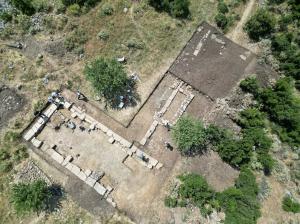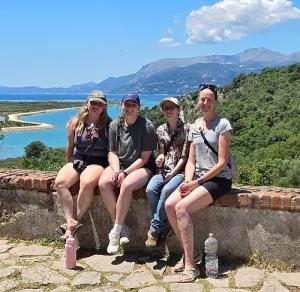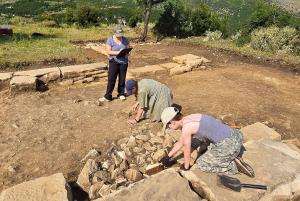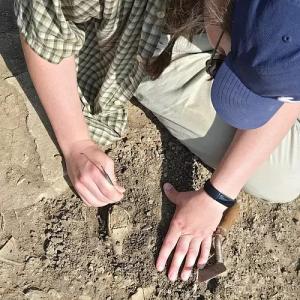Digging Into History: Sweet Briar Students Explore Ancient Albania Through Fieldwork

Three students get hands-on experience in Albania as a part of the Matohasanaj Archaeological Project.
Sweet Briar archaeology students uncover ancient secrets in Albania through immersive summer research and excavation experience.
Led by Assistant Professor Dr. Erin Pitt, the project is a professional research opportunity coupled with a field school. This year, Arin Armistead '25, Alyssa O'Quinn '26, and Bella Perdue '28 benefited from this unique hands-on program, learning excavation techniques, discovering artifacts, and exploring the region and other historical sites.
This year's cohort focused on expanding their understanding of the monumental building from the Hellenistic period (323-31 BCE). Last year's group aimed to discover, hoping to understand the full extent of the building, as well as any possible additions or adjacent structures. While they devoted the majority of their efforts and time to the monument, they also investigated other areas within the fortress that suggested evidence of architectural remains. This included opening several small trenches, where walls and worked bedrock indicated that the areas had been used for housing, industrial purposes, and gates or entrances.
"I personally enjoyed the simple act of digging trenches on site, not only because of the possibility of finding artifacts, but because the action itself was soothing. When I got into the rhythm of scraping a layer of soil, sifting through it for artifactual evidence, and removing loose material from the trench, I felt the world around me fade away. It was only me, the dirt, and the ghosts of a nearly-forgotten society that I wanted to understand better," Arin said of the physical aspects of the project.
Throughout the three-week project, the students worked with Dr. Pitt, the program's co-director, Dr. Sabina Veseli, field director and adjunct instructor Mirgen Shametaj, and field supervisor Dr. Emily Glass, project officer for Archaeology Wales, to remove the latest soil deposits and rubble that had accumulated over the original floor surface of the monumental building. Each student was assigned a minor feature or area that became the focus of their work and represented an important piece of their understanding of the later use and re-occupation of the building, including hearths/cooking surfaces, textile working areas, and post holes for later building phases. The three students were responsible for meticulous excavation, recording their findings through photographs, illustrations, and information sheets, as well as a final write-up that described and interpreted their area. They were also responsible for washing pottery, recording and archiving finds, performing flotation for archaeobotanical materials, and drafting illustrations of notable finds.
The group's hard work significantly expanded their knowledge of the later use and re-occupation of the site. They recovered an extensive building and occupation phase likely dating to the Late Antique (roughly 3rd-8th centuries CE) and Byzantine (330-1453 CE) periods, with evidence of both monumental building and public use, as well as daily industrial activities, specifically textile production. Their investigations also revealed an additional original entrance through the fortress's massive defensive walls that was later reworked and narrowed. Since very little historical and archaeological information is known about these fortresses and the region in general from this last period, these findings are significant to the history of the area.
The team found some spectacular artifacts, including a carved stone relief sculpture of a male and female figure (likely Late Roman or Late Antique, roughly 4th through 7th centuries CE), extensive evidence of textile production, and a significant amount of warped or poorly formed pottery called wasters, suggesting a kiln or local pottery production site in very close proximity.
"The eventual identification of this production site would be extremely significant, since we believe we have a very distinctive local ware that is used at the site that has not been seen on a wide scale and has no known origin," Dr. Pitt said. "It's also significant that we are finding Late Roman or Late Antique material within the fortress. It demonstrates that people ultimately returned to the citadel as the Roman Empire began to weaken and became vulnerable to invasion and economic decline. We believe that this re-occupation was just the beginning of a renaissance for the citadel in terms of its use and importance that continues to the present day."
As a part of the program, students spend 10-14 hours a day with each other and their professors over the course of three weeks. That time is filled with hands-on instruction, highly focused attention, and the opportunity for students to ask questions and seek advice about their academic career and direction post-graduation. As a result, the archaeology and ancient studies program produces well-balanced graduates who possess both extensive theoretical and practical knowledge, enabling them to pursue a variety of pathways upon graduation.
"I am so proud to be able to offer an archaeological experience and field school as a component of Sweet Briar's program. There is something very special about getting to do that fieldwork with your advisors and professors," said Dr. Pitt. "It offers the opportunity to go from the often abstract and theoretical nature of learning the academic discipline of archaeology through textbooks, lectures, and slides, to getting your hands dirty and gaining real-life and marketable experience."
In addition to providing a unique and personalized learning experience, the program enables students to fulfill the major's fieldwork requirement and gain valuable experience that will be beneficial in their careers or graduate studies.
"The project fits into my goals because I want to work in the summer at archeology field jobs eventually, and this gives me the experience and connections to do that in the future," Bella said.
At Sweet Briar, students gain more than a degree—they gain meaningful experience. Whether you're passionate about uncovering ancient civilizations, conducting hands-on research abroad, or studying under faculty mentors who know your name, Sweet Briar's archaeology and ancient studies program is designed to help you dig deeper—literally and academically. If you're ready to start your journey of discovery, visit sbc.edu/admissions or contact admissions@sbc.edu to learn more.
Communications and Marketing
Sweet Briar College
+1 434-381-6262
email us here
Visit us on social media:
LinkedIn
Instagram
Facebook
YouTube
TikTok
X
The College Tour
Legal Disclaimer:
EIN Presswire provides this news content "as is" without warranty of any kind. We do not accept any responsibility or liability for the accuracy, content, images, videos, licenses, completeness, legality, or reliability of the information contained in this article. If you have any complaints or copyright issues related to this article, kindly contact the author above.




